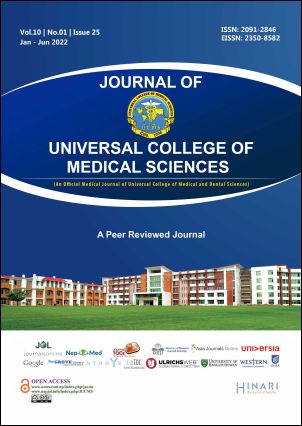Assessment of Knowledge, Attitude, and Practices of Adjunctive Oral Hygiene Aids Brushing Among Medical and Dental Students in UCMS, Nepal
DOI:
https://doi.org/10.3126/jucms.v10i01.47233Keywords:
Knowledge, Oral health, Oral hygiene, Periodontal healthAbstract
INTRODUCTION
Periodontal disease is a bacterial infection that affects tissues that support the teeth and bacterialplaque is the primary cause of this disease. In the interdental spaces, periodontal disorders are more common as a result, removing plaque from these regions is critical. This can be managed by using various interdental cleaning aids such as dental floss, interdental brushes, and chemical agents such as mouth washes. Thus, the aim of our study is to assess the knowledge of other oral hygiene aids except brushing among medical and dental students in a Teaching hospital. This is a knowledge, attitude, and practices model of analyzing the knowledge of adjunctive oral hygiene aids performance and measures other than tooth brushing among medical and dental students.
MATERIAL AND METHODS
A Knowledge, Attitude and Practices (KAP) survey was designed for the present cross-sectional study which was conducted for a period of three months from July 2021 to September 2021 among a sample of 275 medical and dental undergraduates in a Teaching hospital. Pre-tested structured 22-item closed-ended questionnaire was given to each on survey tool and the link was passed to the participants. Statistical analysis was done using SPSS (version 21.0) software.
RESULTS
The response rate for the present survey was 98.9% (272 participants). It was seen that, 29.78% participants reported that poor oral hygiene is the main cause of bleeding and 59.19 % believed that poor oral hygiene is responsible for bad breath. A total of 65.81% reported that most widely recommended interdental aid to be used is dental floss. On gender wise comparison, significant positive response (p< 0.05) was seen among females for items (2,6,11) as compared to males. On stream wise comparison, significant positive response (p< 0.05) was seen among dentists for items (16,17,20) as compared to medical students.
CONCLUSION
The study concluded that dental and medical students must be encouraged to be good role models in practicing as well as promoting oral health for their patients, families, friends and ultimately the society.
Downloads
Downloads
Published
How to Cite
Issue
Section
License
Copyright (c) 2022 Journal of Universal College of Medical Sciences

This work is licensed under a Creative Commons Attribution-NonCommercial 4.0 International License.
Authors have to give the following undertakings along with their article:
- I/we declare that this article is original and has not been submitted to another journal for publication.
- I/we declare that I/we surrender all the rights to the editor of the journal and if published will be the property of the journal and we will not publish it anywhere else, in full or part, without the permission of the Chief Editor.
- Institutional ethical and research committee clearance certificate from the institution where work/research was done, is required to be submitted.
- Articles in the Journal are Open Access articles published under the Creative Commons CC BY-NC License (https://creativecommons.org/licenses/by-nc/4.0/)
- This license permits use, distribution and reproduction in any medium, provided the original work is properly cited, and it is not used for commercial purposes.




